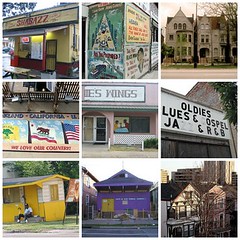Tearing things down
Billed as a strategy for relieving the entrenched poverty of the city’s urban slums, [the teardown] is based on familiar arguments about the alienating effects of large-scale postwar inner-city housing.
But this argument seems strangely disingenuous in New Orleans. Built at the height of the New Deal, the city’s public housing projects have little in common with the dehumanizing superblocks and grim plazas that have long been an emblem of urban poverty. Modestly scaled, they include some of the best public housing built in the United States.
Furthermore:
And finally:If the sight of workers dynamiting an abandoned housing complex was a cause for celebration in Chicago’s North Side, the notion is stupefying in New Orleans, whose public housing embodies many of those same New Urbanist ideals: pedestrian friendly environments whose pitched roofs, shallow porches and wrought iron rails have as much to do with 19th-century historical precedents as with late Modernism.
More specifically, they were inspired by local developments such as the 1850s Pontalba Apartments and late-19th “Garden City” proposals, whose winding tree-lined streets and open green spaces were seen as an antidote to the filth and congestion of the industrial city.
The low red-brick housing blocks of the Lafitte Avenue project, in the historically black neighborhood of Treme, for example, are scaled to fit within the surrounding neighborhood of Creole cottages and shotgun houses. To lessen the sense of isolation, the architects extended the surrounding street grid through the site with a mix of roadways and pedestrian paths. As you move deeper into the complex, the buildings frame a series of communal courtyards sheltered by the canopies of enormous oak trees. Nature, here, was intended to foster spiritual as well as physical well being.
I'm not naive about the problems that have beset public housing in New Orleans and elsewhere. But as you might guess by the fact that I'm now linking to the article a third time, I think it's definitely worth reading.The point is not that projects like Lafitte should be painstakingly restored to their original condition; nor are we likely to return to the same spirit of social optimism that created them any time soon. None of the projects rise to the level, say, of the best Modernist workers housing built in Europe in the 1920s, some of which were such refined architectural compositions that their apartments are now occupied by upper-middle-class sophisticates.
But they certainly rank above the level of much of the conventional middle-class housing being churned out today. And it is not difficult to imagine how a number of thoughtful modifications — the addition of new buildings, extensive landscaping, extending the existing street grid to anchor the project more firmly into the city — could transform the project into model housing.



<< Home